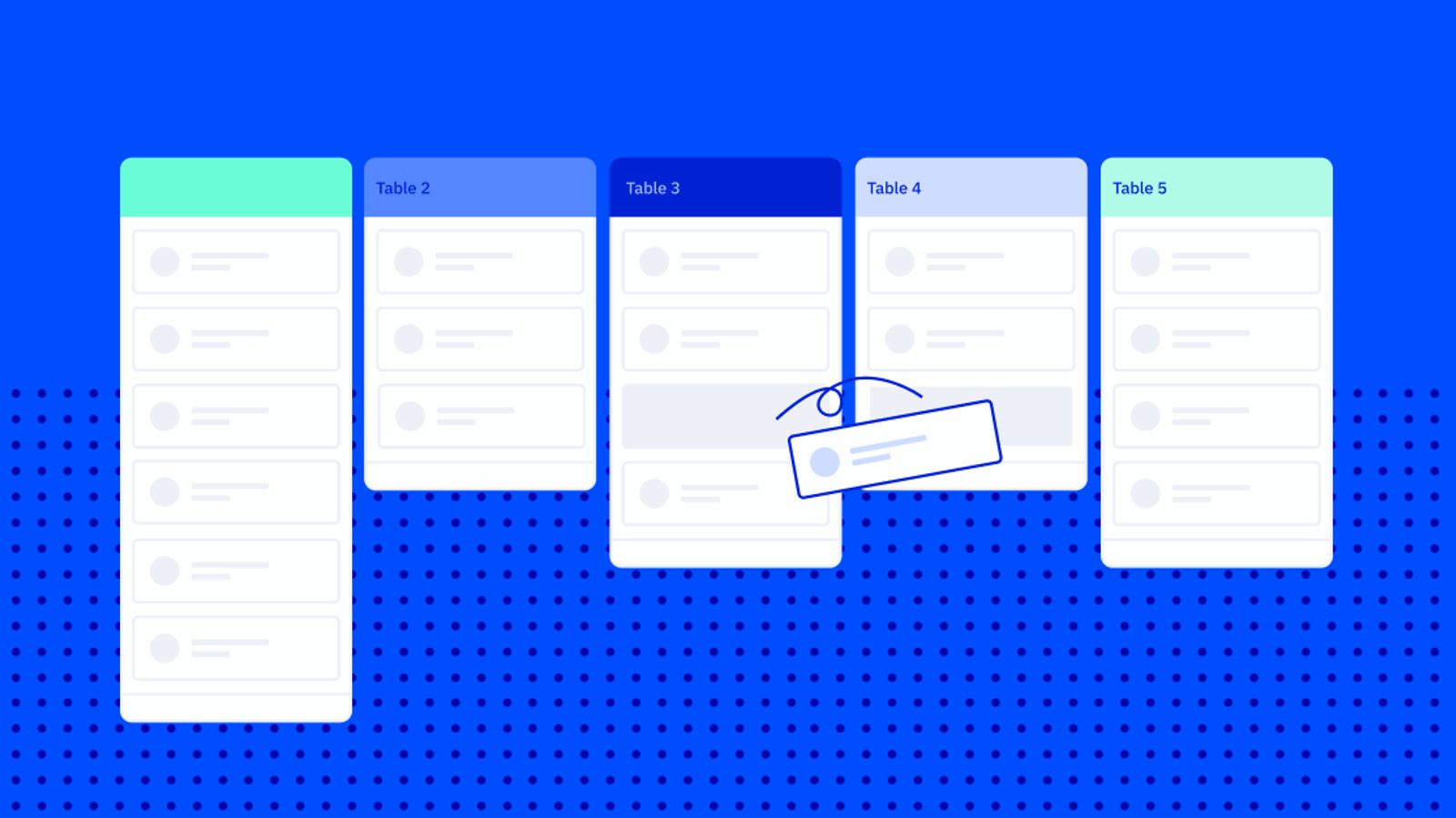You got website traffic! Isn’t that great?
Whether you’re pulling in 100 visitors a week, a thousand, or more, any amount of traffic to your website is a good start for your business. When you fire up Google Analytics and watch the visitors come in, you can sit back in your chair and heave a sigh of relief.
People are coming. People are reading about you. But wait, where are they all going?
Getting traffic to your website is only the first step. Whether it comes through search engines, social media, or word of mouth, most of your website visitors aren’t going to go straight to your contact or product page and give you money.
So they leave. They exit your site, maybe forever, and you’ve missed the chance to stay in contact with a potential lead.
That’s where lead magnets come in.
In this article, we’ll cover everything you need to know about lead magnets, including what they are, how to use them effectively and show you examples of great lead magnets already working for other businesses.
What is a lead magnet?
You may have heard the term lead magnet before. If not, they go by a lot of different names you could have heard of:
- Opt-in incentive
- Signup offer
- Opt-in offer
- Opt-in bribe
- Carrot
- List bait
So what is a lead magnet? By any name, it’s a lead-generation technique to get more people to give you their email addresses. Essentially, you’re dangling a carrot in front of them.

Specifically, a lead magnet is when you offer something—a checklist, ebook, consultation, or trial—in exchange for an email address.
Instead of asking people to “subscribe to your newsletter,” which isn’t really that compelling, you offer them some kind of content or service that solves their problem.
What makes lead magnets the best method of building an email list? It gives people a reason to do something.
Think about it. You want people to sign up for your email list so that you can send them content and sell to them. But what do they get?
Yeah, they get your content. But what do they get right now? All of the best list-building strategies have 1 thing in common—they give people something in return for joining your email subscriber list.
If you want to grow your email list, you usually need to give people something in return. There’s actually psychological research on the topic—the concept is called the “norm of reciprocity.”
That something you give them? That’s a lead magnet.
Does a lead magnet get you more customers? Not right away. But by collecting information from people interested in what you have to say, you can follow up with nurture campaigns (even automated ones) and convert sales that would have been otherwise nonexistent.
Why are lead magnets important?
Lead magnets help you increase conversions and build an email list that grows your business.
Often, you won't be able to convert website visitors into customers the first time they land on your site. But you can start by collecting their information and work on getting them to convert in the future.
If you haven’t built an email list yet, you should start yesterday.
Marketing expert Ryan Holiday calls an email list your most important career asset, and writer Jeff Goins claims that everyone needs an email list. There’s simply no better way to send private, personal messages to your fans. All the best marketers agree.
But let’s say you already have a list. You put up a signup form on your site to collect email addresses so you can stay in touch. You wait. You wait some more.
Nothing. Your website is underperforming. Maybe you get half a percent of visitors to sign up.
What if you could drive that number up? If you could increase your conversion rate to 4%—which is generally a pretty good conversion rate—what would that do to your business?
It’s hard to answer that question in the abstract, so let’s walk through a simplified example with some numbers.
Say you have a website that brings in 10,000 visitors per month, with a conversion rate of .5%. That means your email list grows by about 50 subscribers every month.
If your average revenue per email subscriber is $7, you’re bringing in $350 of revenue per month just from your website traffic.
Okay, so what happens if you increase your conversion rate? We’ll keep all the other numbers the same but plug in a conversion rate of 4%.
At 10,000 visitors per month, a 4% conversion rate brings you 400 new email subscribers every month. At an average of $7 per subscriber, that’s $2800 worth of revenue! Over the course of a year, that’s almost $30,000 extra that you generate without any additional work.

Is this a simplified example? Of course. It doesn’t take into account email list churn (or the extra word of mouth and traffic that comes from having a larger list).
But it shows how moving just that 1 number (your conversion rate) can hugely affect your business.
What makes a good lead magnet?
There are 3 key characteristics of effective lead magnets.
1. Targeted at a specific problem
A great lead magnet solves a single problem.
When you create a lead magnet, throwing everything in your arsenal is tempting. Doesn’t it make sense to give leads everything they possibly want?
Eventually, yes. But not at first.
If you bombard people with a dozen different messages, you can freeze them into inaction. But who wouldn't take action if you gave them a single message to focus on, 1 that solves an acute, burning pain?
Darya Rose of Summer Tomato helps people lose weight without dieting. When you visit her website, you’ll quickly be delivered this offer. She does a great job of targeting a specific problem:

Even though her opt-in copy has a few different benefit points, all of her points are focused on the same message—lose weight without dieting. Each specific benefit serves to reinforce that overarching goal, and the result is compelling.
When you create your lead magnet and write your opt-in copy, keep in mind the problem you’re trying to solve and why you’re the 1 who can solve it.
2. Targeted at a specific audience
Along with targeting a very specific pain point, lead magnets are more effective when they can target a specific niche audience.
In some of the examples we’ve given, an entire business is focused on a specific niche. Introverted Alpha, run by Sarah Jones, is a website devoted to helping introverted men date more without feeling disingenuous.
Here’s its opt-in offer:

Introverted men who don’t like “pick-up artists” are ultra-specific, making the messaging even more compelling.
But what if you run a slightly more general business?
The best option is to segment your audience.
Platinum Skin Care’s lead magnet converted at 17% (remember, those are paid conversions) because it gave people exactly what they needed.

Offering lead magnets specific to each audience will improve your conversion rates.
3. Offers a (perceived) quick win
The best lead magnet ideas solve a problem right now.
Why do people download your lead magnets? Because it solves a problem. People with problems want those problems solved as quickly as possible—ideally with as little work as possible.
That’s why checklists and videos work well as lead magnets. They promise to solve problems and are easy to consume immediately—a quick win.
When you create a lead magnet, your job isn’t to give people what they need. It’s to give people what they think they need.
In a perfect world, what people actually need would be the same as what they think they need.
But this isn’t always the case. Maybe someone needs a system that helps them count calories to lose weight, but they think they need a list of healthy recipes (even though they’ll download the list and not use it).
If you offered them a CalorieTrackerSpreadsheet™, why would they sign up? They don’t think they need that.
If you offer a list of healthy recipes, you can stay in touch. You can help move them throughout the customer lifecycle to the point where they better understand their own needs.
Then you can pitch them the thing that solves their problem.
This kind of mismatched messaging shows up all the time. Usually, it’s because you, as the expert, have knowledge that your audience doesn’t. So you need to meet your audience where they are to really help them.
13+ types of lead magnets and examples
Below you’ll find 13 types of opt-in offers (with a few miscellaneous ones thrown in) to help spur lead magnet ideas.
There are a few examples from the marketing industry—but we specifically looked for lead magnet examples from various businesses. You’ll find opt-in offers from law firms, fitness businesses, tutoring, ecommerce, life sciences, and more.
The newsletter is so good that it doesn't need a lead magnet.
Or does it? You'll have to decide. Put in your email, and we'll send you our best marketing advice once each week.
1. Checklists
Checklists are a fantastic lead magnet idea for 2 simple reasons:
- They’re easy to use
- They’re easy to make
The most effective lead magnet ideas offer things that can be used immediately. If you want to get someone’s information, you have to entice them with a pretty strong offer—and they will want that offer’s benefits immediately.
Checklists fit the bill! A one-page outline for a specific process gives your subscribers all the information they need at a single glance.
Illumina, a life sciences company known for selling DNA sequencers, uses a checklist to attract leads. Because it sells sequencers, its checklist lists things to look for when buying a sequencer.
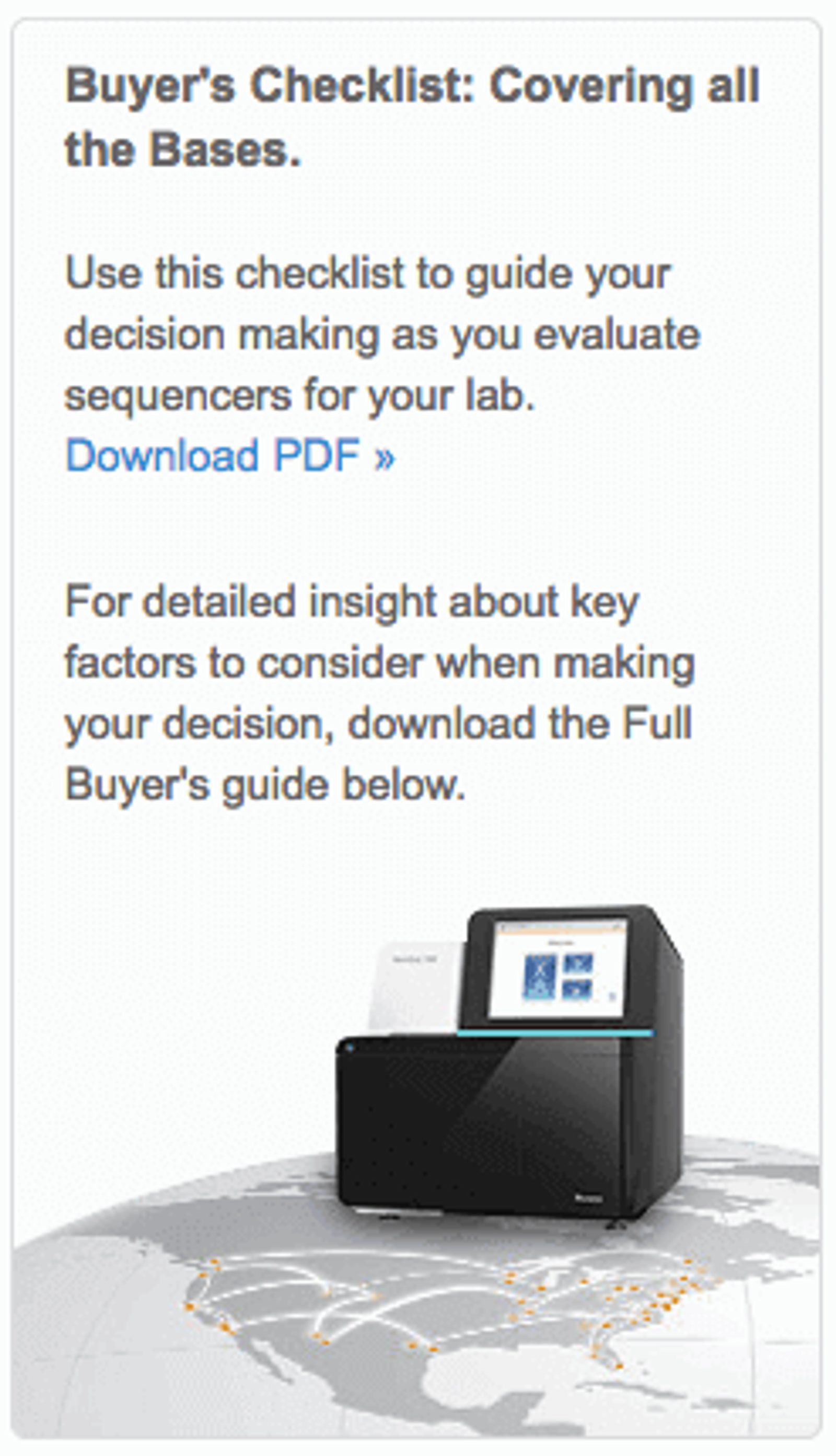
In a wildly different niche, Phyzzle is a company that helps engineering and physics students excel in their degrees. Phyzzle uses several different lead magnets, but 1 of them is a checklist for engineering students.

Finally, to return to the marketing world, SEO and lead generation expert Brian Dean offers an SEO checklist at the end of his post on… SEO checklists.
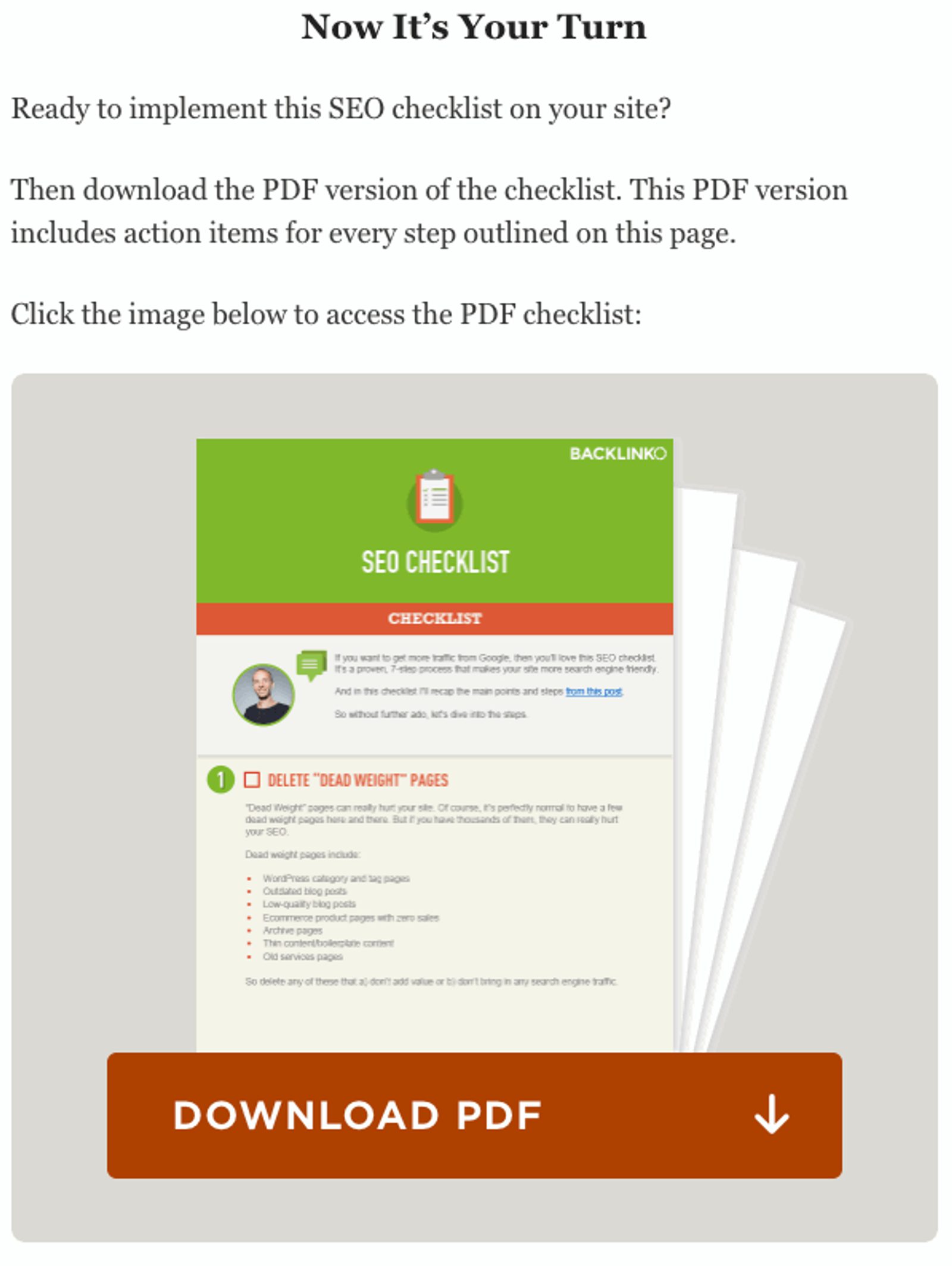
Note that this is also a good example of offering a lead magnet related to a specific piece of content. We’ll talk more about “content upgrades” towards the end of this article.
2. Cheat Sheets
Wait, what’s the difference between a checklist and a cheat sheet?
Cheat sheets are similar to checklists but tend to have a bit more information. Instead of showing steps to a process, a cheat sheet will usually have background information on a specific topic—for when you need to see it at a glance.
ChartMogul, a company that provides analytics for SaaS businesses, offers a SaaS metrics cheat sheet as a lead magnet.

This cheat sheet runs through a lot of the key terms that show up when you work at a SaaS company. If you aren’t big on the financial side of SaaS, having a cheat sheet that goes through terms like MRR, ARPU, LTV, and churn could be really valuable.
In an extremely different industry, Peter Nguyen, a men’s style coach, uses cheat sheets as part of his “style starter pack.”

A guy having trouble finding clothes that fit would surely appreciate a cheat sheet based on their body type.
3. Ebooks and Guides
Ebooks and guides are 1 of the most common lead magnet ideas.
While ebooks aren’t always practical because reading them sounds like too much work to the prospect, they can be effective—especially if they contain tons of helpful information and guides.
Often, people who read a whole ebook are more likely to turn into your customers.
You should keep the copy tight if you use an ebook as a lead magnet. It can be long—especially if you’re providing massive value. But it needs to stay engaging throughout.
Larry Law Law is a site focused on helping law students get through law school and start their legal careers. Law school—and the bar examination—are notoriously challenging. So an “ultimate guide” to law school success sounds pretty tempting, right?
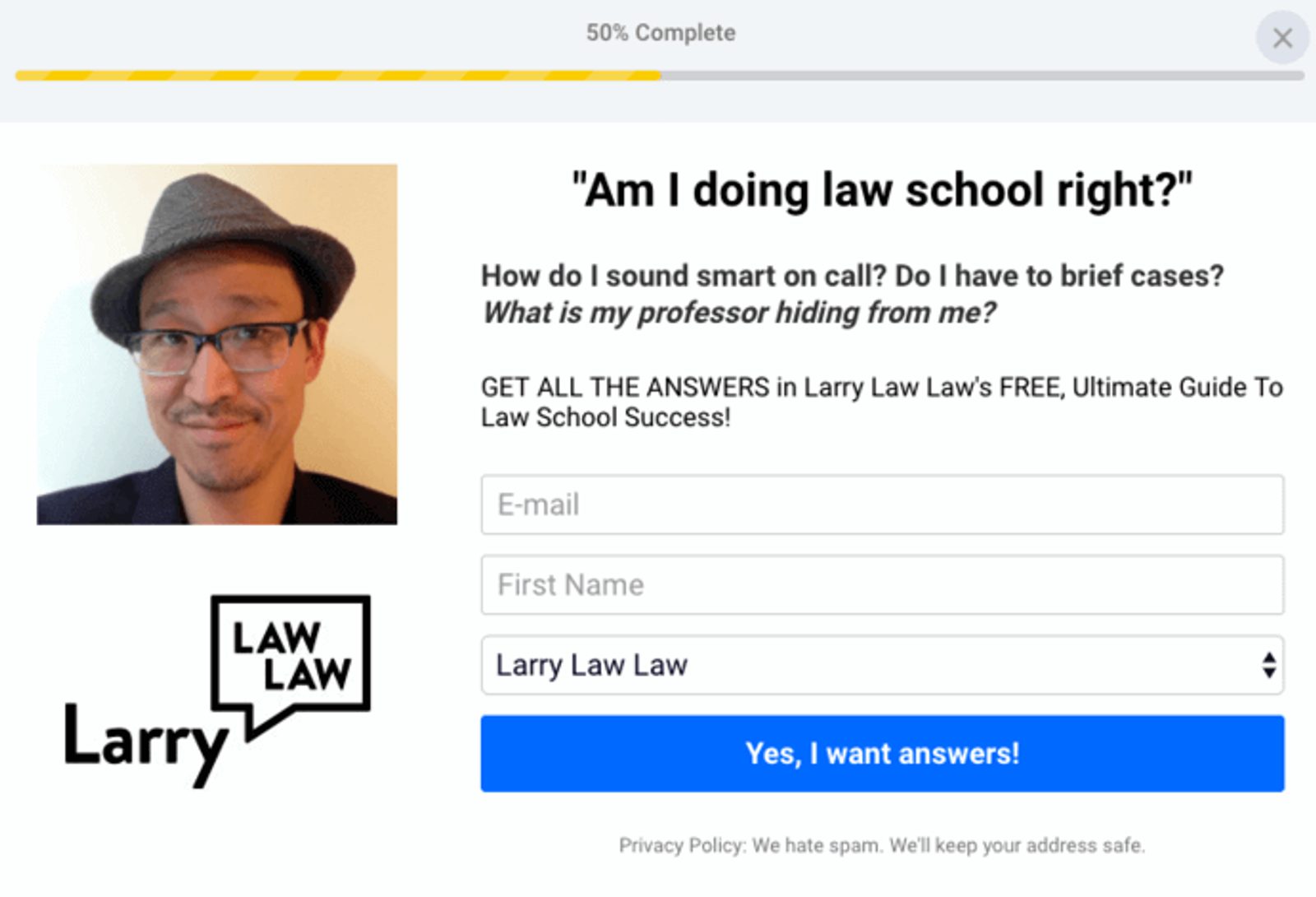
Upon landing on Introverted Alpha’s website, the first thing you see is an ebook lead magnet.

And, of course, there’s a similar website for women. Camille Virginia of Master Offline Dating helps women find men to date without using online dating. The very first thing you see when you land on her site?

Also, notice that the picture of Camille is looking toward the opt-in button. This is a classic conversion rate optimization technique because it helps draw attention to the offer.
Guides and ebooks can be really useful ways to increase conversions, and they’re really easy to put together—just write them and export them as PDFs.
The key in each of these lead magnet examples? The businesses have identified specific niches and created offers that solve specific problems. Reading a guide or ebook is a time investment. But people will do it if they think it will solve their problems.
4. Email course
Email courses are excellent lead magnets to create since they’re fairly easy to put together and don’t require you to create anything downloadable.
An email course is simply an autoresponder email series that teaches prospects how to do something. There can be anywhere from 3-10+ emails in the series covering the topic in depth.
Creating a free email course takes almost zero technical know-how. You don’t need to know how to design anything. You can create a free email course if you can set up a simple welcome series in your marketing automation platform.
And, since users are familiar with email, you don’t need to waste time explaining complicated platforms that other courses are generally hosted on. Instead, users can simply jump right in and start the email course.
For example, Elna Cain is an online course creator with a 6-day email course that teaches users the steps to become full-time freelance copywriters.
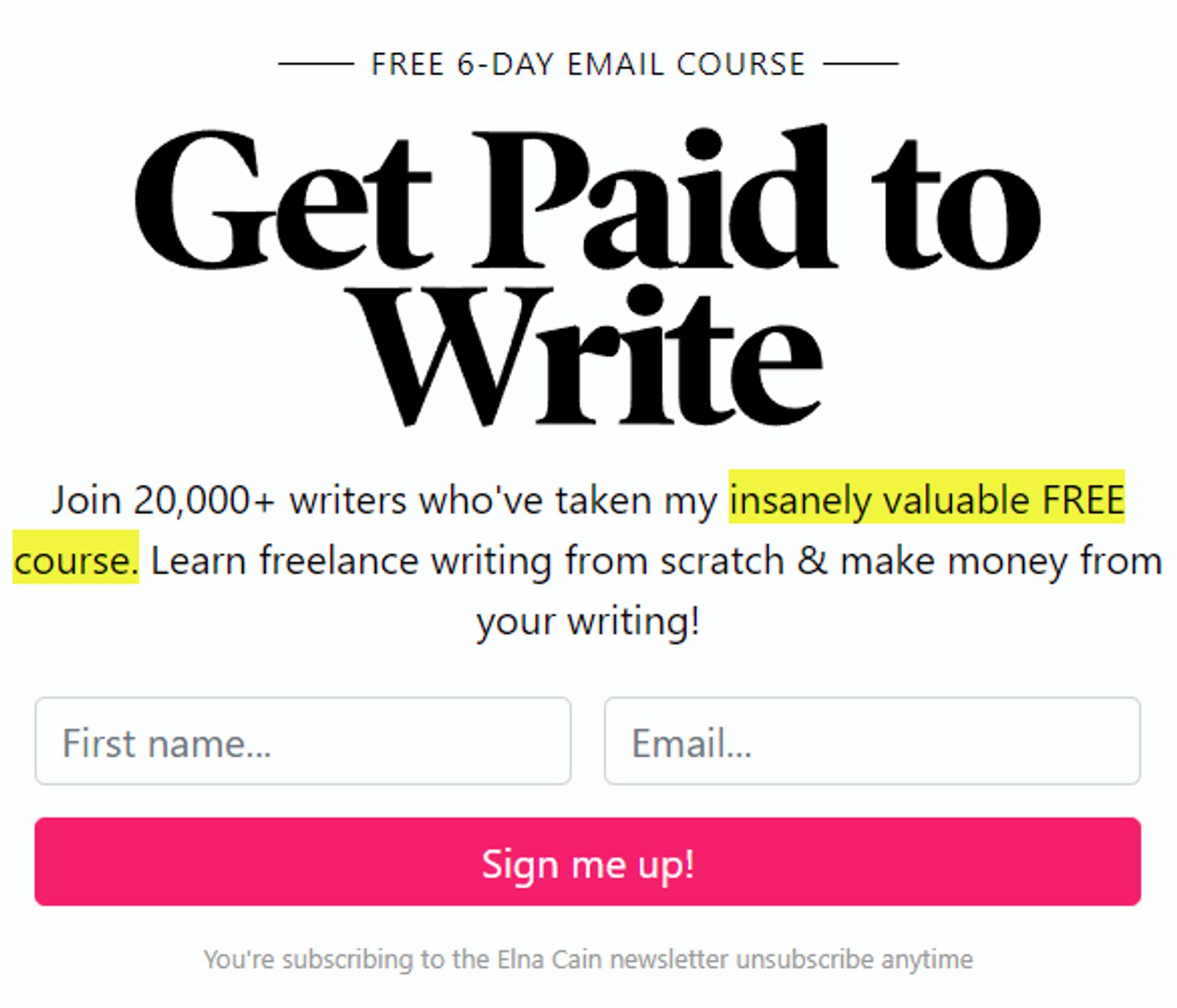
UltyResults, a company that teaches ultimate frisbee players to do strength and conditioning, offers a free course on sport-specific workouts.

And remember Phyzzle? It has a few different lead magnets, 1 of which is a free 5-day course on studying for exams.
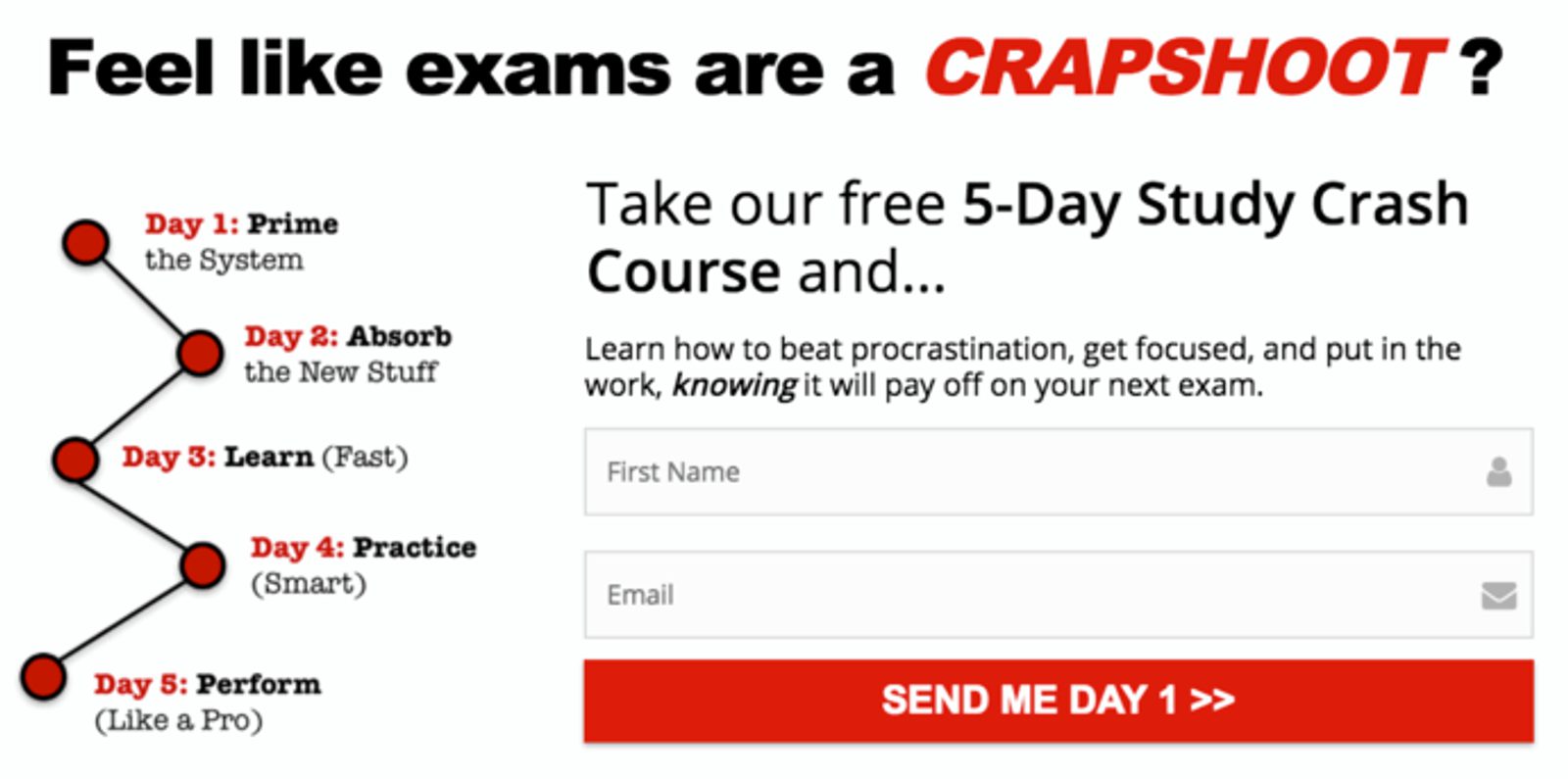
As long as your free email course solves a major pain point, it can be an effective lead magnet.
The gratification for an email course isn’t immediate (people have to wait for each email)—but there’s something to be said for having contacts look forward to your emails. For that reason, email courses are often a really nice segue into lead nurture campaigns.
Are you interested in this type of lead magnet? Learn how to create your own email course.
5. Free videos
Video is an engaging form of content, but some people are nervous about using video lead magnets because of how hard it is to create them.
At the same time, videos can make really effective lead magnets for 2 reasons:
- They are extremely consumable
- They have a high perceived value
Watching a 9-minute video takes less effort than reading a 20-page ebook for most people. And because video is relatively more difficult to produce, the people who produce it have an advantage.
But, making videos can be easy.
Yes, great production value is hard. Video editing can be difficult if you run an established business—or the type of business where your customers expect your work to have high production quality.
Also, having the resources and know-how to make great videos opens up more options for the types of videos you can produce.
But for many small businesses, most of the time, people aren’t expecting outrageous production value. If you have a message that is easiest to relay through video, shoot it on a phone or starter camera.
That’s what our 2 examples did, which made sense for the type of businesses they run.
Eric Cressey of Cressey Sports Performance is a strength and conditioning coach focusing on baseball players (especially pitchers). He’s widely renowned as an expert in the field—both because of his prodigious technical skills and the great content he publishes.
So what do you see when you land on his site?

A video on deadlifting.
That’s a pretty compelling offer, coming from a world-class deadlifter.
Note also that this video doesn’t need to be anything spectacular from a production standpoint. You could film it on a potato, and most people would still watch because of Cressey’s expertise—a phone will get the job done.
Remember Darya Rose of Summer Tomato from earlier? She also offers a video lead magnet.

Each of these examples illustrates 1 of the strengths of video.
For Cressey, can you imagine how hard it would be to write a manual on deadlifting? Can you picture yourself at the gym trying to read through a stack of papers on squeezing your glutes? It’s much easier to present that information visually.
Summer Tomato’s video could probably have been presented as a written guide—but creating a video increases the perceived value of the opt-in incentive.
Grow Your Subscribers With Automation
6. Reports
Reports tend to be more appealing to a technical or B2B audience. But if you’re in that type of industry, they can be a powerful lead magnet.
Knowing industry benchmarks and trends is really valuable. So valuable that some reports cost thousands of dollars to access. If you have the capability to offer some kind of valuable report for free, it can be a powerful lead magnet.
MuleSoft, a company that helps software interact with other software, offers a whole host of reports that they use for lead generation.
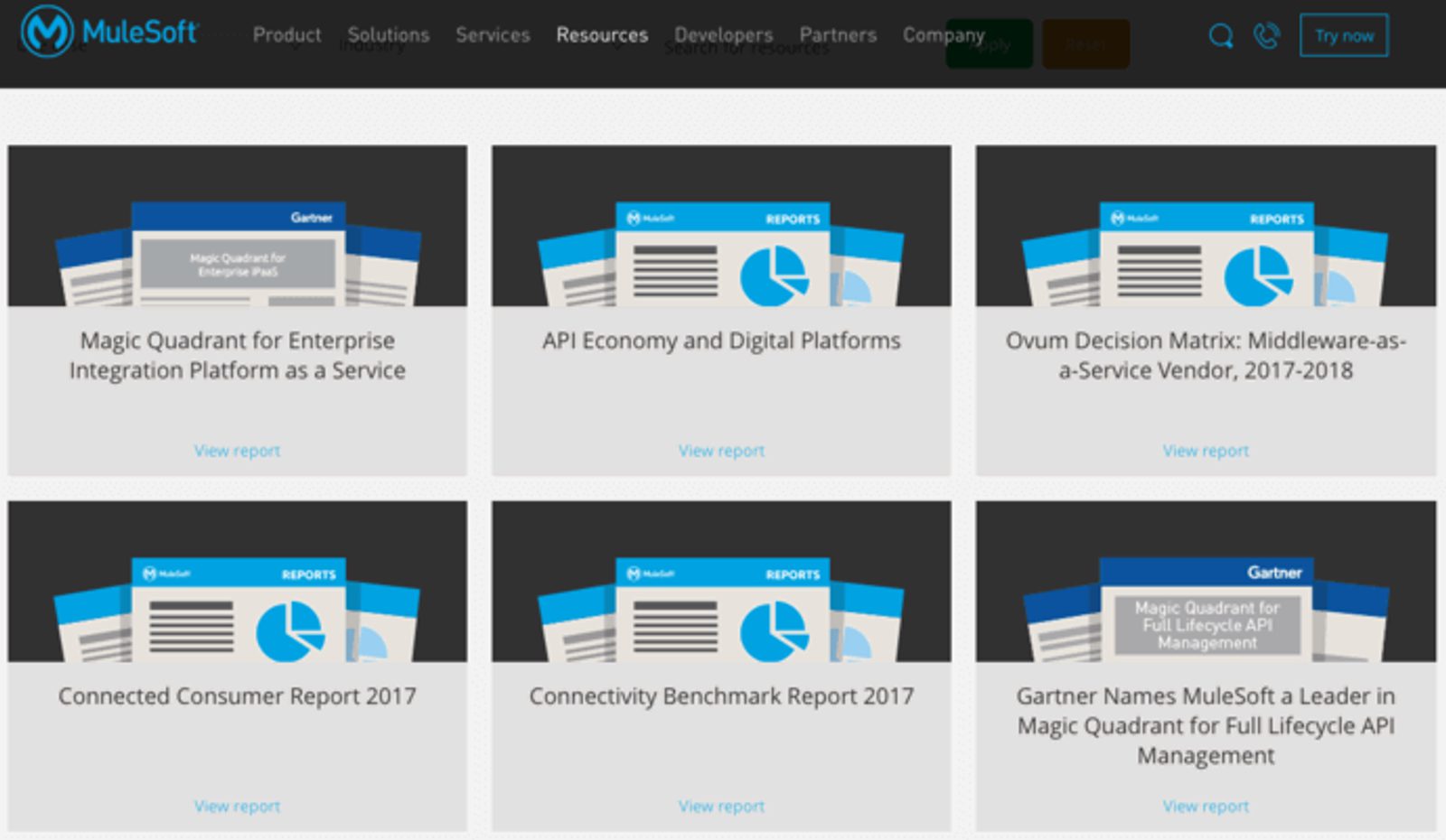
If you have access to a data source and the know-how to analyze it, a free report can be a really effective lead magnet idea.
7. Free trials
Free trials are an incredibly common lead magnet, especially for SaaS companies.
If you have a product you can offer for a limited time, there’s no better way to show potential customers what they could be getting. Especially when products are expensive, customers are much more likely to buy if they can try your platform themselves.
The example for this 1 is simple: ActiveCampaign!
We offer a free, 14-day free trial. You can check out our trial if you’re interested in the platform (or just want to see what a free trial signup page might look like).
8. Coupons and discounts
A lot of the examples so far—for guides, checklists, and videos—are harder to pull off in certain industries. Downloading a checklist from an ecommerce site is kind of a tough sell.
That’s why many ecommerce sites use a different type of lead magnet—one specifically tailored to their business model.
Coupons and discounts can be an effective way to collect email addresses—and sometimes convert them directly into customers. Saving money is compelling. Because a huge part of ecommerce is picking up first-time buyers, it makes sense to use coupons to attract them.
A lot of ecommerce sites keep their subscriptions simple, saying something like “sign up to get notified of the latest deals.” That’s ok, but you can take it a step further.
Australian clothing retailer Cotton On offers a 20% discount for signing up for its email list.
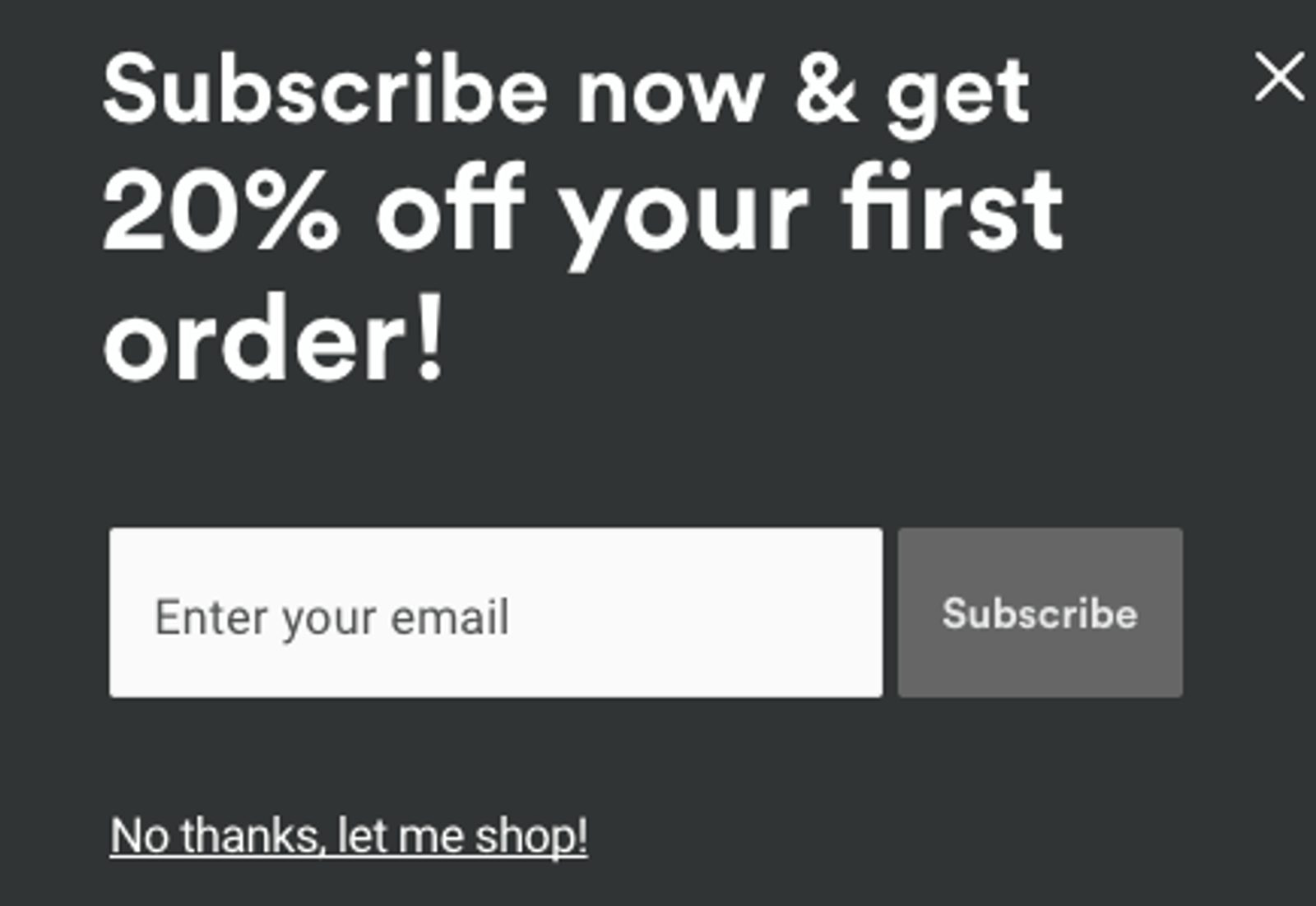
Look at how simple that is! It doesn’t take any complicated design work. Just a simple box that flies in and offers a discount.
Craftshack, an online beer store, offers a similar discount for joining its email list.

If you’re interested in a product but not convinced, a coupon might be just the push you need to give up your email address. That makes them an attractive lead magnet.
9. Templates and examples
Creating a template or sample can be an effective way to show value if you have the artistic ability that your audience needs.
Lucidpress is a company that sells easy-to-use design software. One of its major lead magnets is a collection of ebook templates.
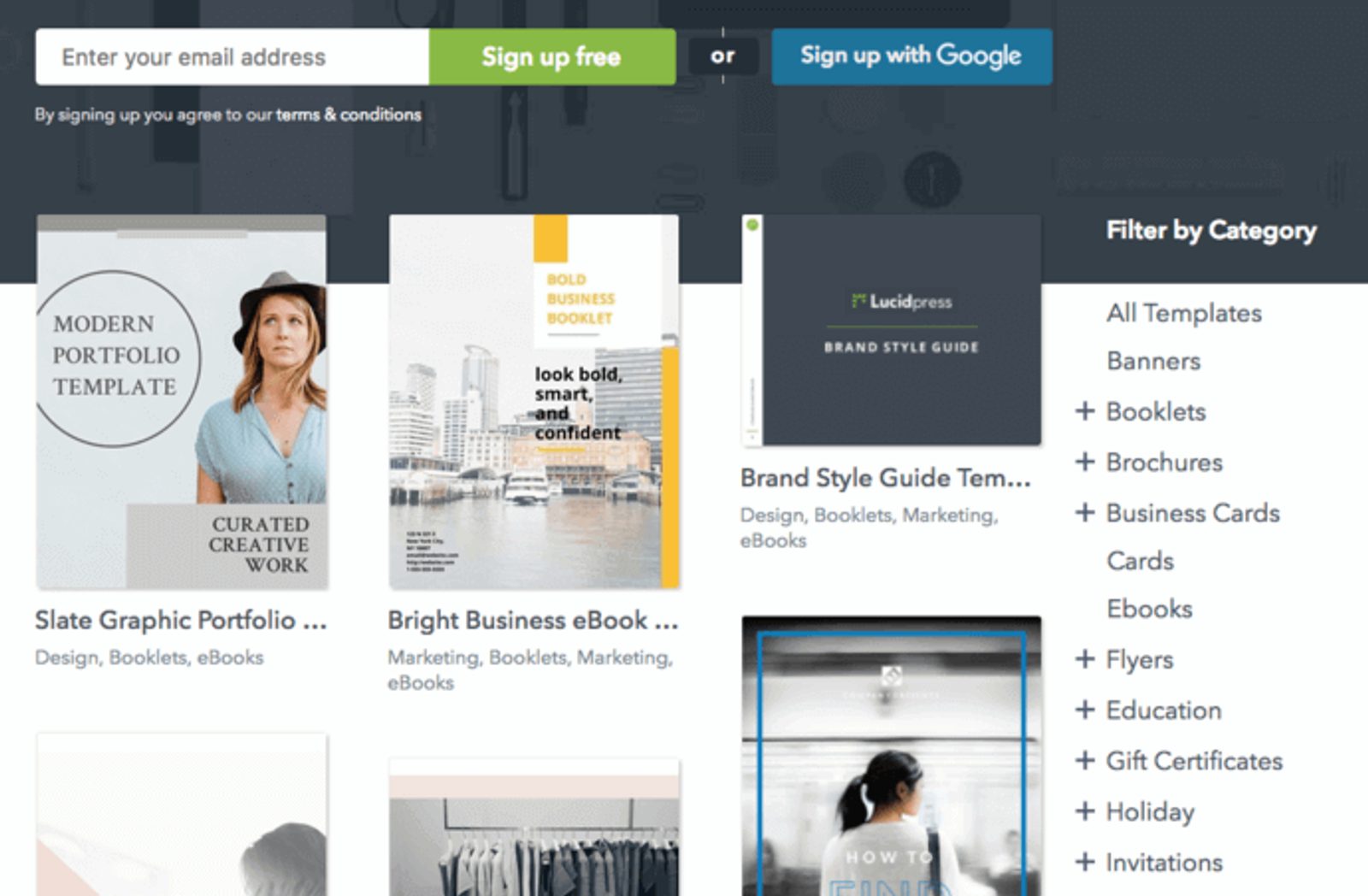
If you need to create a beautiful ebook but don’t have any design skills to speak of, having a template to work from would be really valuable.
Similarly, Bidsketch is a software company that helps you design proposals. One of its lead magnets is a free trial—but it also offers the chance to look at a sample proposal generated by the software.

This shows off its software’s capabilities and provides value to its audience. Sometimes looking at the layout of an existing proposal for inspiration is all you need to write your own.
10. Consultations
In many service-based industries, free consultations can be a great lead magnet.
Sometimes all people want is the chance to speak to an expert about their problems. In many cases, you might be able to answer questions in minutes—when those same questions would have taken hours of Googling for people to answer on their own.
On your end, a consultation helps you qualify leads by figuring out 2 things:
- Whether you’re the best fit to help someone with their problem
- Whether they have the willingness to pay for help
The law firm Markhoff & Mittman (aka “The Disability Guys”) offers both a free guide to worker’s compensation and consultation on their home page.

Offering both a consultation and a free guide helps them further qualify leads. Consultations can be effective, but they also take up lawyer time. Ideally, prospects towards the bottom of the funnel take the consultation—while everyone else uses the free guide.
Athletico, a physical therapy organization founded in Chicago, offers a complimentary injury screen to new patients.

What’s great about Athletico is that this online form probably doesn’t drive that many consultations. But Athletico has locations all over the city and in multiple states—every brick-and-mortar location also has a prominent invitation to come in for a consultation.
For ActiveCampaign, our 200+ email templates- make for a great place for customers to dive into, and can also double as lead magnets
11. Quizzes
Who doesn’t love taking online quizzes? BuzzFeed proves that quizzes can be a way to generate massive traffic and engagement.
Quizzes can also be used as a great lead magnet. And because they make people choose between different answers, you can even use them to segment your audience by interest.
Ramit Sethi of I Will Teach You to Be Rich and GrowthLab offers a quiz as the opt-in incentive on his home page.

The chance to get customized advice on earning more money is pretty compelling.
And because Sethi creates content on diverse topics like investing, negotiating salaries, freelancing, and starting an online business, I’d be willing to bet he uses the results of the quiz to segment his audience.
Platinum Skin Care used a quiz to segment its website visitors and offer them the best products for its specific needs.

This quiz was so effective that it had a 17% paid conversion rate—17% of people who took it turned into customers right after being offered a product.
You can listen to CEO Jennifer Tilney talk about its approach to using a quiz as a lead magnet.
Quizzes and segmentation can make your lead magnets even more effective.
12. Webinars
If you run webinars to sell your products—or just for thought leadership—you’d probably like to make your investment in them evergreen.
Offer it as an opt-in incentive. One example of this comes from online marketer Neil Patel, who has used webinars to build his email list.
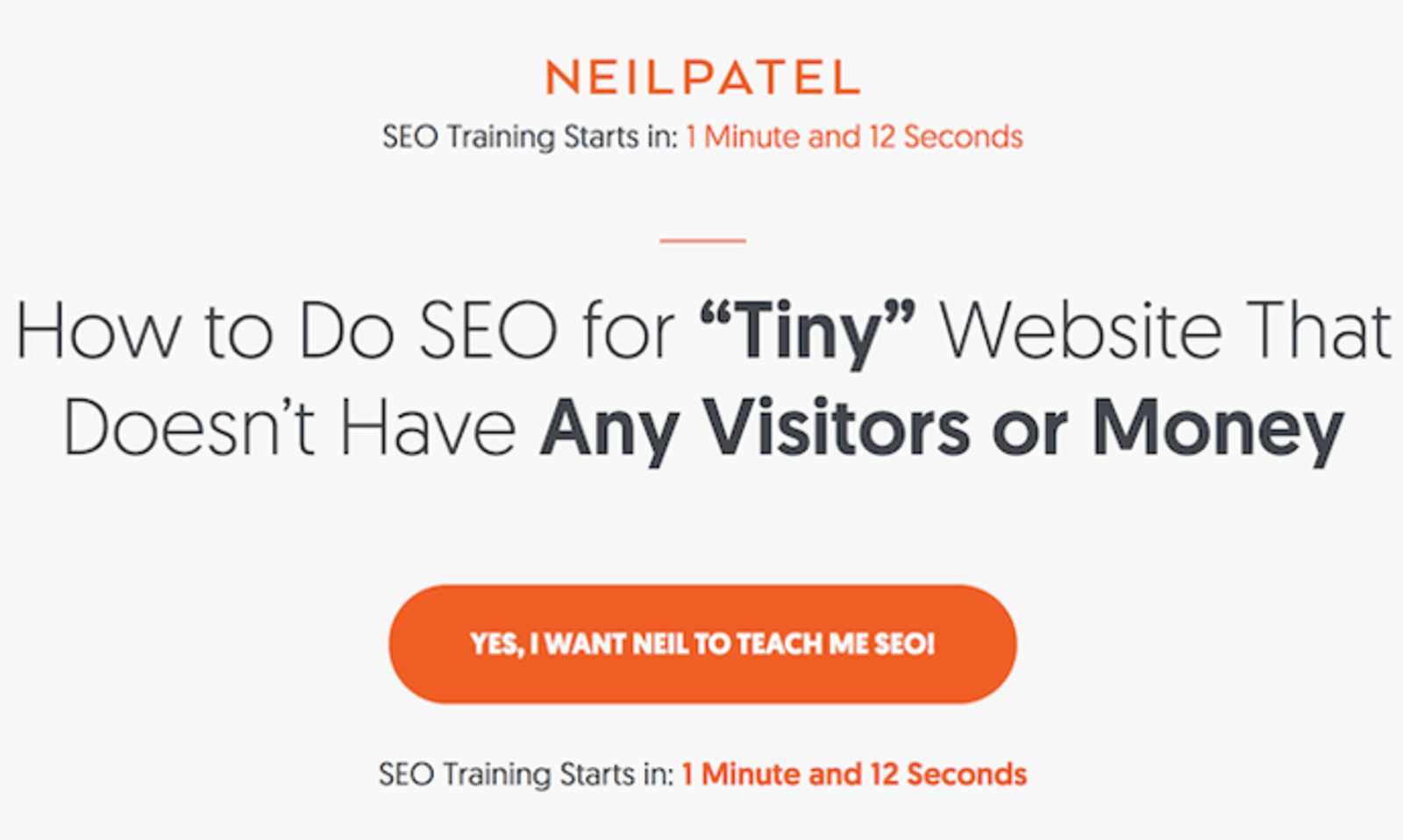
Webinars are closely related to videos but can be a bit different. They tend to be longer in form and often involve having slides with voice-overs instead of featuring you on camera.
13. Miscellaneous
We finally made it. The last category is the “plus” in “13+ types of lead magnet.”
The truth is, not all lead magnet ideas fit neatly into 1 of the above categories. But any lead magnet can be effective if it solves your audience’s needs.
If you break away from the 12 major categories we’ve covered, your lead magnet ideas will be highly specific to your business and audience. But a pair of examples might still help you develop new ideas.
Chris Johnson is a physical therapist who also helps train runners. When you visit his website, the first thing you see is an invitation to access “world-class running drills.”

Maybe the prospect used to run cross country in high school and college and has been repeating those workouts. Or perhaps they don’t know how to train for running besides just running as long as they can.
Either way, a simple list of drills would be handy if they were trying to get more serious about running.
In a very different example, DebtHelper is a non-profit organization that helps people get out of credit card debt. One of its major lead magnets is a spreadsheet that helps people organize their expenses.

Spreadsheets aren’t usually considered “attractive,” but if it solves a burning pain like credit card debt, almost anything could be an enticing lead magnet.
BONUS! 57 more lead magnet ideas (for dozens of industries)
There are as many different lead magnet ideas as there are businesses. If you have the resources and creativity for it, you can turn just about anything into a lead magnet.
We include these bonus ideas in case they spark some source of inspiration. Not all of them are widely used—and for some, it’s hard to find a good example of it working.
But 1 of these ideas could be a winner for the right business (maybe yours?).
Here are 57 more creative lead magnet ideas:
Informational lead magnets
- State of the Industry: Your review or research on the state of your industry.
- Predictions: Your expert predictions on events in the near future.
- Case studies: Show people that others like them have had success with you.
- Survey: Promise to show people the survey results if they participate.
- PDF version of a guide: Take your article or guide… and just turn it into a PDF!
- Gated content: Website content that people can only access after filling out your lead capture form.
- Powerpoint and Presentation Slides: Hand over your presentation slides so people can learn directly from them.
- Original data: Put together original research (numbers no 1 else can get).
- Infographic: Give readers data, information, or a guide in a visual format.
- Recipe: Offer some of your best recipes that aren’t available anywhere else.
- Newsletter: Sometimes, your email newsletter can be so irresistible that it’s a lead magnet—especially if you share funny, entertaining content.
- Tutorial: Step-by-step guide where you teach users to do something.
- Transcript: Repurpose a video into a transcript that people can read.
- Educational audio: Make an audio recording where you’re giving a live lesson.
- Whitepaper: Create an authoritative, persuasive report on a specific topic that shows a problem and provides a solution.
- Mind map: Explain a complex subject in an easily digestible way.
- Replay: Save a recording of your live presentations or webinars and use it as a lead magnet.
- Predictions: Make some predictions about your industry and publish them as a downloadable file.
- Audiobook: Create an audiobook from 1 of your ebooks and use it as gated content.
- Podcast: A long podcast that’s a deep dive into a specific topic.
- Real-world evaluations: Give real-world assessments of the value of certain products/services with accompanying data.
- Polls: Get a group of people to vote on a specific matter and create a document containing the results.
- Income report: Share your income streams with people interested in using you as a mentor to get the same job.
Tools
- Toolkit: A collection of tools related to a specific topic.
- Resource List: Links to the best resources on a topic.
- Calculator: Let people put in their own numbers, then email them the results.
- Swipe file: A folder or document with valuable ideas or writing examples that users can simply copy and use.
- Worksheet/workbook: Sheets with questions and spaces that prospects can use to complete exercises or figure something out.
- Planner: A plan that you’ve mapped out that the user can simply follow.
- Web app: A free tool on your site where users can login if they want to use it.
- Calendar: A calendar that gives people certain tasks to perform on specific dates.
- Inspiration file: Give users a neatly packaged folder with tons of images or examples they can use as inspiration.
- Library/vault: Put all your lead magnets or resources together so people can access it all at once (mainly for high-ticket prospects).
- Mobile app/game: A free mobile app or game that users can access by creating an account with you.
- Prompt: Give your prospects writing, design, or journaling prompts to help them get started.
- Catalog: A complete list of items/tools/resources typically written in alphabetical order.
- Generator: Create a tool that generates ideas, business names, book characters, etc.
Templates and samples
- Word-for-word scripts: Give people the exact words to say in a situation.
- Manifesto or Mission Statement: Share your mission (or mission statement template).
- Printable: Provide a graphic design or text file as a digital download that people can fill out.
- Free book chapter (text): Give away a section of your book (in ebook format).
- Free book chapter (audio): Give away a section of your book (in audio format).
- Digital product sample template: Give away a part of your template for free.
Other
- Certifications: Offer a certification program or badge to get people in the door.
- Quotes: Send users inspirational quotes daily, weekly, or monthly to keep them motivated.
- Desktop wallpaper: Give users a free desktop wallpaper or poster.
- Waiting list: Put prospects on a waiting list to be notified first as soon as your product/course is launched.
- Giveaways: An online raffle!
- Contests: Like a raffle, but people can get extra entries by sharing with their network.
- Free book + shipping: Offer your prospects a free book where they just pay for the shipping.
- Free business assessment: Offer a free business assessment where you tell a prospect what their business needs to improve.
- Free coaching session: Give prospects a free business or training coaching session.
- Access to a private group: Offer prospects the chance to access a private Facebook group.
- Free quote: Offer a free quote directly from your site after the prospect fills out their requirements.
- Challenge: Gain highly qualified leads by creating a creative challenge that your ideal customers can participate in.
- Event tickets: Offer free or discounted tickets to your business event.
- Book notes: Create book notes for popular books that students and business professionals often read.
If the first 13 ideas didn’t do it for you, hopefully, these give you a bit more to think about.
How to create a lead magnet
Now that you have an idea of the types of lead magnets that are out there, here are the steps you need to take to create an effective lead magnet that your ideal buyers will want.
Step 1: Determine your target audience
The first step in creating your lead magnet is determining who exactly your ideal customers are. What are their struggles? What are their wants and needs? What are their interests?
The best way to determine your target audience is to look at their demographics, psychographics, and cognitive thinking.
- Demographics: Education, income, employment, geographical location, etc.
- Psychographics: Values, desires, goals, struggles, lifestyle choices, etc.
- Cognitive thinking: Knowledge, comprehension, ability to solve problems, etc.
If you want to know your audience even better or if you have multiple audience segments, the best practice would be to create detailed buyer personas where you go into detail about your ideal clients (i.e., write down their exact age, profession, habits, etc.).
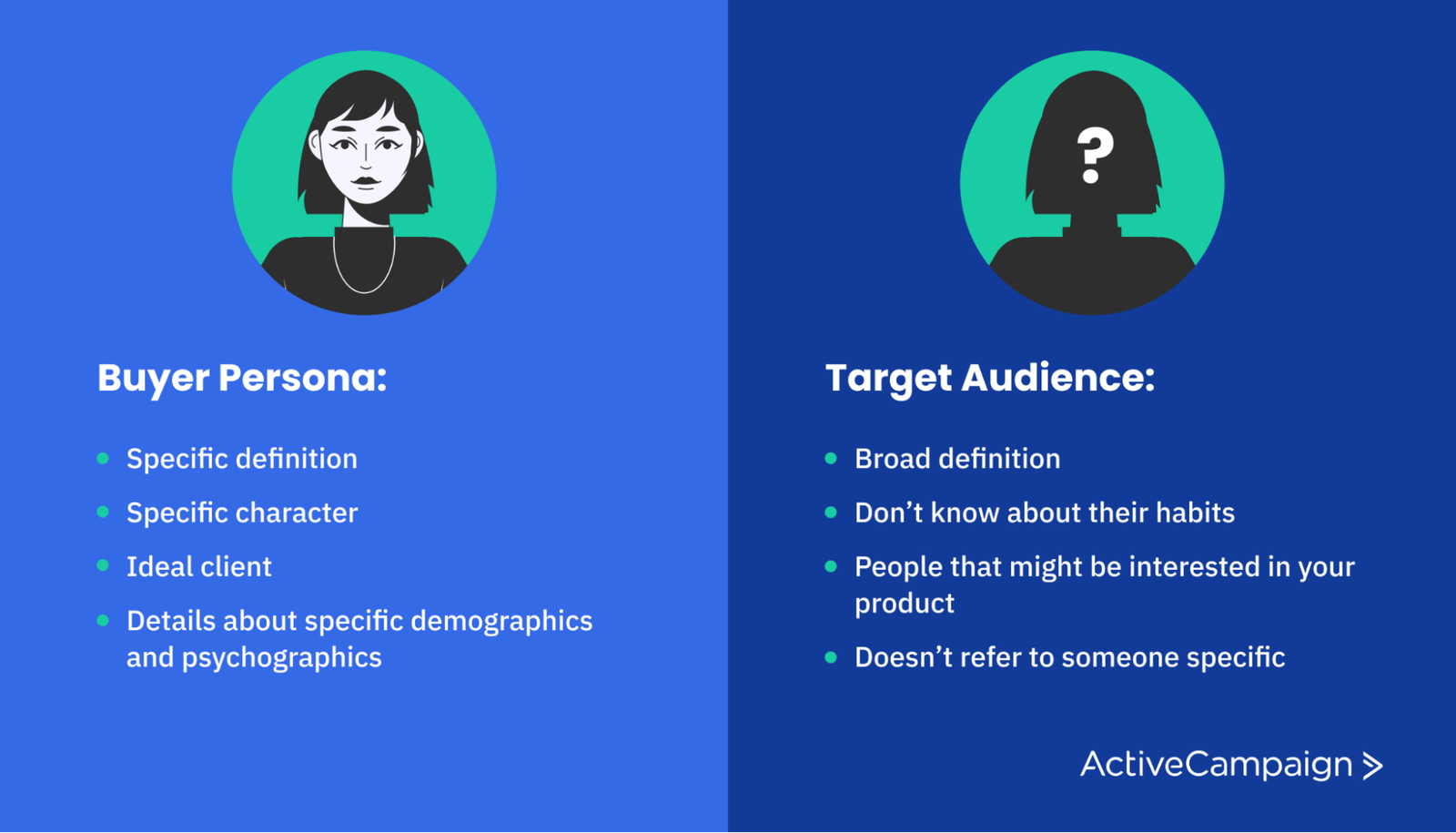
Step 2: Design and name your lead magnet
If you have the budget to hire a graphic designer or video editor, that’s great. If not, you can still create eye-catching lead magnets using the following free tools.
Canva
Canva is an awesome design service that lets you make simple graphics. What makes Canva so great? It’s super easy to use.
The service has put together over 30 design tutorials showing you how to use it.
In Canva, everything is drag and drop. You don’t need to learn any complicated software or memorize hex codes for colors.
Marketers love this tool. In 2022, Canva has over 75 million active users, with approximately 150 designs created every second.
You can use Canva to create:
- Infographics
- Images for ebooks, guides, and checklists
- Headers for PDFs
Google Docs
Huh? Yeah, Google Docs is free, but how can you use it to create a lead magnet?
Google Docs isn’t the most sophisticated way to make a lead magnet, but it has 2 significant benefits.
- It’s fast
- It’s easy
In Google Docs, you can type up an ebook, guide, checklist, cheat sheet, or other written resource to use as a lead magnet.
Then, use a free design tool like Canva to make a simple header for the lead magnet. It doesn’t need to be amazing, but having a header makes your lead magnet look less like something typed up quickly in Google Docs.
After that, all you need to do is download the Google Doc as a PDF.

Boom. You’ve got your lead magnet.
Your phone
Ok, you got me. Phones aren’t free.
But chances are you already have a smartphone and that it comes with some free video editing software.
If you’re putting together a simple lead magnet, video can be really valuable. As we discussed, video content has a high “perceived value.” That is—people like it.
It won’t be quite the same as a video with super high production value—but for most lead magnets, the content is more important than the video itself.
Don’t hesitate to shoot the video on your phone and use it as your lead magnet.
Prezi
Prezi is a presentation software that makes it easy to design engaging talks. Instead of using just “slides” like PowerPoint, Keynote, or Google Slides, Prezi gives you more flexibility in how you design stuff.

Once you’ve designed a presentation—or even an ebook—you can export it as a PDF to use as a lead magnet.
You can also use PowerPoint, Keynote, or Google Slides for this if you prefer.
Audacity
What if you want to make an audio lead magnet? Recording audio on your phone is easy enough—but how can you edit it?
Audacity is free, open-source audio software.

Is the software incredible? Not really. A professional might choose something different.
But at the same time, producing professional-quality audio in Audacity is possible. And if all you need to do is create an audio lead magnet, Audacity will get the job done.
Step 3: Deliver your lead magnet
Once your lead magnet is created, you need a way to offer and send it to people who subscribe. Email is usually the best way.
In ActiveCampaign, lead magnets get delivered through forms and automations. By building a custom form for your site (which you can embed anywhere you like), you can offer different magnets on different pages.
Then, once a form is filled out, you can trigger automated emails that deliver the lead magnet—and even start a follow-up sequence.
If you don’t have much marketing automation experience, this video from the free course Getting Started with ActiveCampaign is a good place to start.
And, of course, you can subscribe people to your lists and add tags whenever they complete a form.
Step 4: Update your lead magnet regularly
Nobody likes outdated content. Make sure that your lead magnets are updated regularly to keep up with trends and your audience’s needs.
According to Statista, 60% of marketers worldwide use customer data when making marketing decisions. This proves that data is your number 1 best friend when creating lead magnets that your audience will love.

Three tips to boost lead magnet conversion rates
What if you’ve followed the best practices for lead magnets, put a lot of effort into making one, and still don’t have a good conversion rate?
One thing you might be tempted to do is jump straight into conversion rate optimization (CRO). You might get ready to do a ton of split testing and A/B test every part of your page to increase conversions.
Eventually, split testing is the best way to increase conversion rates. Before you sink a lot of time, energy, and money into split testing, ensure you’re following some simple best practices.
If you implement these changes and still don’t see much change to your conversion rates, go ahead and think about split testing (or take a step back and consider your overall positioning).
But here are a few quick wins that can increase conversions before you go all-in on conversion rate optimization.
1. Use a pop-up
Even though people sometimes find pop-ups annoying, they convert like crazy.
Add a pop-up (also called a lightbox or a modal) to your website, and you should increase conversion rates pretty quickly.
There are a variety of tools you can use to add a modal to your website, but some of the most popular include:
If the idea of adding a pop-up form to your website makes you uncomfortable, consider using an “exit-intent” pop-up.
Exit-intent forms are a great middle-ground between annoying and effective because they only appear when a visitor is about to leave your site. That way, you can collect contact information without interrupting the viewing experience on your website.
Most of the popular list-building tools can create an exit-intent form, and using 1 could help you make the most of your lead magnet.
2. Dynamic content
Copy may be the most overlooked yet powerful way to improve conversion rates.
It seems a little strange to call copy/content overlooked. Doesn’t everyone know that you need to have opt-in copy?
Yes. But there’s a huge difference between having copy and having copy that converts.
Copywriting is an entire field—some people spend their entire careers focusing on just copy. If you really want to go deep on copywriting, Copyhackers is a site with great resources for increasing conversions.
If you just need more conversions for your lead magnet, try following these 5 copy guidelines:
- Clear writing: If people don’t know what you’re offering, they won’t convert. Get rid of marketing-speak, and don’t try to write clever puns until your offer is crystal clear.
- Natural language: Speak simply. Write plainly. Avoid using a lot of jargon and sound conversational. The easier it is to understand what you’re saying, the more likely people will convert.
- Benefits: You can offer someone a guide, checklist, video, or report. But why should they want it? Make sure you tell people how your lead magnet will help them.
- Emotion: The strongest copy is emotional. Your lead magnet solves a burning pain for your audience. Make sure your copy reflects that pain—make sure they feel like your lead magnet can solve it.
- A call to action: As silly as it sounds, people won’t download your lead magnet just because it’s there. You need to tell them to sign up with a clear CTA.
Let’s look at Summer Tomato’s opt-in copy for the third time.

The copy for this offer is excellent. It instantly and clearly communicates a clear benefit: “get a body you love without dieting.”
A great headline is the first step to grabbing attention, especially if you’re using a popup to increase conversions. You need to get attention fast—and a boring headline is the best way to get people to close out your popup. Will Hoekenga of Copygrad has an outstanding guide on writing great headlines for any offer.
And look at how emotional the language is!
- “Dieting rollercoaster”
- “Ridiculous diet rules”
- “Make your life awesome”
- “Body you love”
Great copywriting extends to the call to action (CTA) copy. “Show me” isn’t that much more compelling than “learn more”—or even worse, “submit.”
Look for ways to amp up the emotion and clarity in your opt-in copy. You’ll increase conversions quickly.
3. Use a content upgrade
Wait, a “content upgrade?” I thought we were talking about lead magnets.
We are. A content upgrade is a term coined by Brian Dean of Backlinko—and using them increased his conversion rate by 785%.
A content upgrade is a subset of lead magnets in general. When you have a high-performing blog post on a specific topic, you have an opportunity to offer a content upgrade.
Instead of offering your standard, generic lead magnet, why not point people to a lead magnet specific to the content they just read?
An excellent example of this comes from Peter Nguyen, a men’s style coach who writes at The Essential Man.
One of his highest-performing blog posts is called “How to Buy Your First Leather Jacket.” On its own, this is a good piece of content. But look at what Nguyen offers in the middle of the post.

People reading about how to buy a leather jacket are probably interested in leather. So he offers them a guide about leather as a great “content upgrade.” It’s a lead magnet related to what you know people are interested in—because they’re already reading about it.
If you’re having trouble getting conversions, consider creating content upgrades for the pages of your site that have the most traffic. You’ll increase conversions on blog posts pretty quickly.
Conclusion: How to grow your email list with lead magnets
Creating a compelling lead magnet is a great idea if you’re having trouble growing your email list.
With lead magnets, you immediately offer solutions to your audience's problems before they even subscribe to your lists.
By delivering value upfront, you can convert more of your website visitors into contacts—and get more sales from leads who would otherwise have disappeared.



